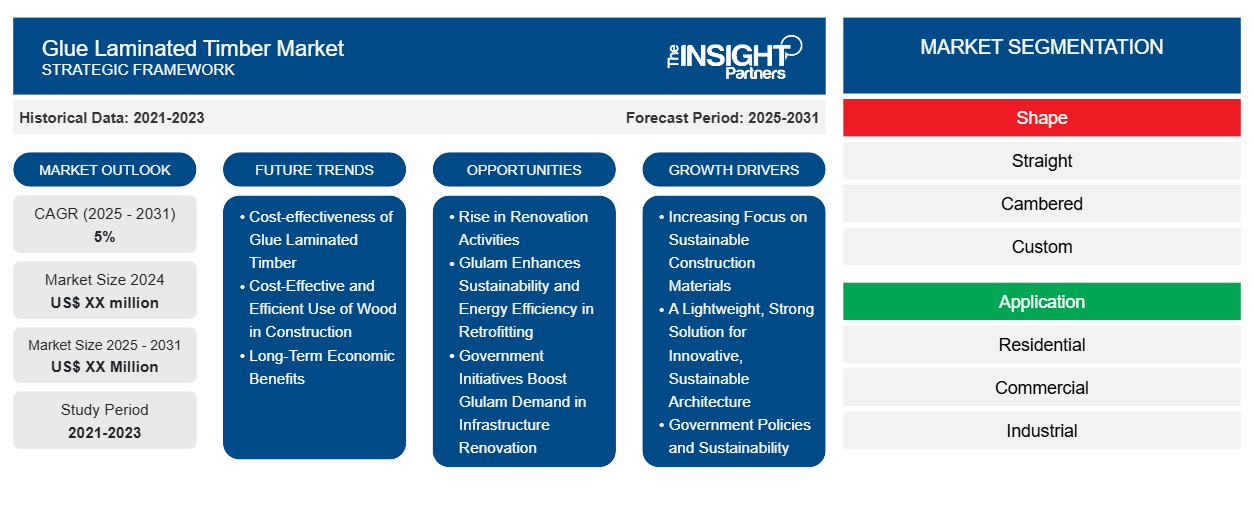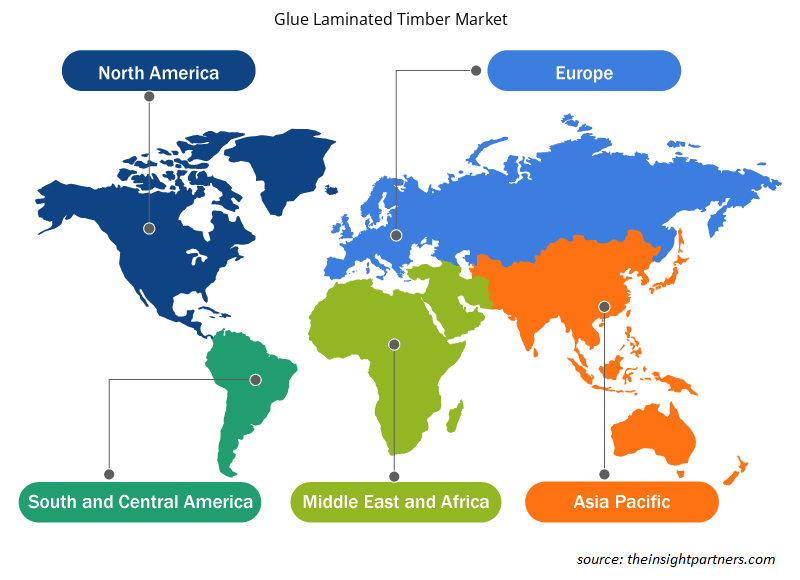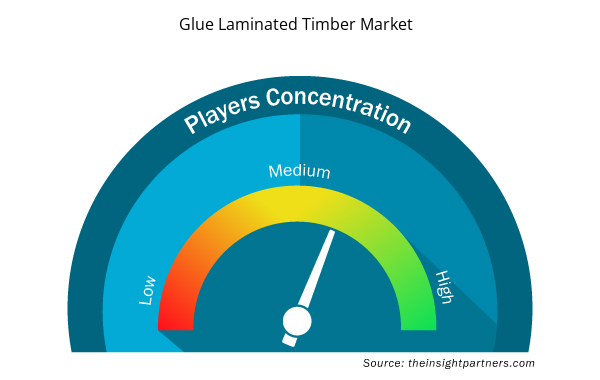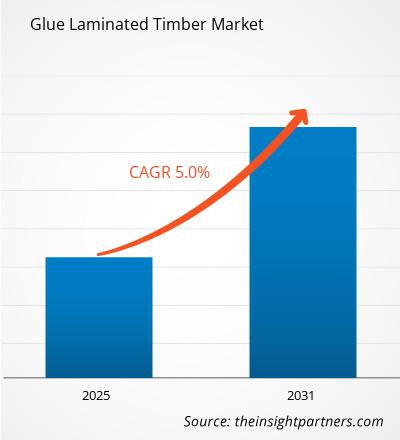The Glue Laminated Timber Market is expected to register a CAGR of 5% from 2025 to 2031, with a market size expanding from US$ XX million in 2024 to US$ XX Million by 2031.
The report is segmented by Shape (Straight, Cambered, and Custom). Based on Application report is segmented into (Residential, Commercial, and Industrial). The global analysis is further broken-down at regional level and major countries. The Report Offers the Value in USD for the above analysis and segments.
Purpose of the Report
The report Glue Laminated Timber Market by The Insight Partners aims to describe the present landscape and future growth, top driving factors, challenges, and opportunities. This will provide insights to various business stakeholders, such as:
- Technology Providers/Manufacturers: To understand the evolving market dynamics and know the potential growth opportunities, enabling them to make informed strategic decisions.
- Investors: To conduct a comprehensive trend analysis regarding the market growth rate, market financial projections, and opportunities that exist across the value chain.
- Regulatory bodies: To regulate policies and police activities in the market with the aim of minimizing abuse, preserving investor trust and confidence, and upholding the integrity and stability of the market.
Glue Laminated Timber Market Segmentation
Shape
- Straight
- Cambered
- Custom
Application
- Residential
- Commercial
- Industrial
Customize This Report To Suit Your Requirement
You will get customization on any report - free of charge - including parts of this report, or country-level analysis, Excel Data pack, as well as avail great offers and discounts for start-ups & universities
Glue Laminated Timber Market: Strategic Insights

- Get Top Key Market Trends of this report.This FREE sample will include data analysis, ranging from market trends to estimates and forecasts.
Glue Laminated Timber Market Growth Drivers
- Increasing Focus on Sustainable Construction Materials: The growing demand for sustainable building practices leads to a rapid increase in the glue-laminated timber market. As environmental concerns rise, architects and builders are seeking materials with a lower carbon footprint. Glulam is a renewable alternative to conventional building materials like steel and concrete produced by bonding together a few layers of wood through adhesives.
- A Lightweight, Strong Solution for Innovative, Sustainable Architecture: In fact, beyond sustainability, the benefits of glulam extend to its lightweight but incredibly strong component, providing for some of the most creative and innovative architectural designs. This not only adds appeal to a vast array of uses-from small residential homes to commercial buildings but also serves well as the demand for LEED certification and other green standards grows.
- Government Policies and Sustainability: Besides, government policies toward using eco-friendly materials are still driving the market forward. Sustainable resource usage in construction is providing incentives, prompting more builders to use glulam. This positive trend is in line with efforts to address global climate change situations: glulam will play a vital role in shaping the face of more conscious eco-architecture in the near future.
Glue Laminated Timber Market Future Trends
- Cost-effectiveness of Glue Laminated Timber: The current trend driving growth in the glue laminated timber (glulam) market is cost-effectiveness. As construction budgets become tighter, builders are seeking materials that offer affordability along with durability. Glulam is attracting wide interest due to its cost-effectiveness and economical value combined with attributes that best describe engineered strength, thus being a very appealing option for many projects.
- Cost-Effective and Efficient Use of Wood in Construction: This means as much 'meat' of the wood is used in the glulam production process, thereby saving waste and costs. Since it is composed of smaller, less structurally sound pieces of wood, producers can produce beams of considerable strength that compete very favorably with solid wood equivalents. This cost-effective approach has helped both the builders and the forestry itself.
- Long-Term Economic Benefits: Other added advantages of glulam include long-term economic benefits. Its durability results in lesser maintenance and repair in the long run. As more contractors realize these financial benefits, demand for glulam is expected to increase, which could lead to further improvements and innovations in production techniques and applications.
Glue Laminated Timber Market Opportunities
- Rise in Renovation Activities: This continuous transformation in the market allows retrofitting of existing structures using glue-laminated timber, as well as aging cities, to upgrade and strengthen older structures. In many ways, it is light and strong, allowing an easy increase in the structural integrity without having to make drastic changes in the building.
- Glulam Enhances Sustainability and Energy Efficiency in Retrofitting: Most old buildings exhibit sustainability problems and energy inefficiency. Incorporating glulam into zones enhanced the sustainability issues associated with the retrofitted buildings, making them friendlier to the environment. The replacement of heavy materials with glulam decreases the overall weight and increases the value of energy efficiency, a benefit that could already be seen in modern sustainability goals.
- Government Initiatives Boost Glulam Demand in Infrastructure Renovation: In addition, government initiatives that encourage the reconstruction of worn-out infrastructure continue to drive the demand for Glulam in retrofitting applications. Today, most people care about the green use of material, and on this count, glulam is a viable choice. In aesthetics, it adds value to the space retrofitted and increases interest among owners and developers.
Glue Laminated Timber Market Regional Insights
The regional trends and factors influencing the Glue Laminated Timber Market throughout the forecast period have been thoroughly explained by the analysts at Insight Partners. This section also discusses Glue Laminated Timber Market segments and geography across North America, Europe, Asia Pacific, Middle East and Africa, and South and Central America.

- Get the Regional Specific Data for Glue Laminated Timber Market
Glue Laminated Timber Market Report Scope
| Report Attribute | Details |
|---|---|
| Market size in 2024 | US$ XX million |
| Market Size by 2031 | US$ XX Million |
| Global CAGR (2025 - 2031) | 5% |
| Historical Data | 2021-2023 |
| Forecast period | 2025-2031 |
| Segments Covered |
By Shape
|
| Regions and Countries Covered | North America
|
| Market leaders and key company profiles |
Glue Laminated Timber Market Players Density: Understanding Its Impact on Business Dynamics
The Glue Laminated Timber Market market is growing rapidly, driven by increasing end-user demand due to factors such as evolving consumer preferences, technological advancements, and greater awareness of the product's benefits. As demand rises, businesses are expanding their offerings, innovating to meet consumer needs, and capitalizing on emerging trends, which further fuels market growth.
Market players density refers to the distribution of firms or companies operating within a particular market or industry. It indicates how many competitors (market players) are present in a given market space relative to its size or total market value.
Major Companies operating in the Glue Laminated Timber Market are:
- Binderholz GmbH
- Boise Cascade
- Calvert Co., Inc.
- Canfor
- Eugen Decker
Disclaimer: The companies listed above are not ranked in any particular order.

- Get the Glue Laminated Timber Market top key players overview
Key Selling Points
- Comprehensive Coverage: The report comprehensively covers the analysis of products, services, types, and end users of the Glue Laminated Timber Market, providing a holistic landscape.
- Expert Analysis: The report is compiled based on the in-depth understanding of industry experts and analysts.
- Up-to-date Information: The report assures business relevance due to its coverage of recent information and data trends.
- Customization Options: This report can be customized to cater to specific client requirements and suit the business strategies aptly.
The research report on the Glue Laminated Timber Market can, therefore, help spearhead the trail of decoding and understanding the industry scenario and growth prospects. Although there can be a few valid concerns, the overall benefits of this report tend to outweigh the disadvantages.
- Historical Analysis (2 Years), Base Year, Forecast (7 Years) with CAGR
- PEST and SWOT Analysis
- Market Size Value / Volume - Global, Regional, Country
- Industry and Competitive Landscape
- Excel Dataset



Report Coverage
Revenue forecast, Company Analysis, Industry landscape, Growth factors, and Trends

Segment Covered
This text is related
to segments covered.

Regional Scope
North America, Europe, Asia Pacific, Middle East & Africa, South & Central America

Country Scope
This text is related
to country scope.
Frequently Asked Questions
Cost-effectiveness of Glue Laminated Timber is expected to be the key market trends.
Based on geography, Asia Pacific held the largest share of the glue laminated timber market.
Based on shape, cambered, is expected to witness the fastest growth during the forecast period
Binderholz GmbH, Boise Cascade, Calvert Co., Inc. are some of the key players operating in the glue laminated timber market
Increasing Focus on Sustainable Construction Materials is driving the market growth
The Glue Laminated Timber Market is estimated to witness a CAGR of 5% from 2023 to 2031
Trends and growth analysis reports related to Chemicals and Materials : READ MORE..
1. Binderholz GmbH
2. Boise Cascade
3. Calvert Co., Inc.
4. Canfor
5. Eugen Decker
6. Glulam Ltd
7. PFEIFER GROUP
8. Schilliger Holz AG
9. Setra
10. Structurlam Mass Timber Corporation

 Get Free Sample For
Get Free Sample For